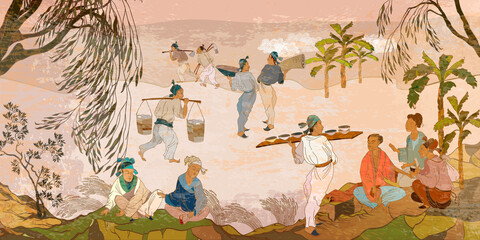Evolution of Tea in China
When the Chinese started drinking tea almost five thousand years ago, they sipped it for its health-giving properties. They found that the brew refreshed them, cured stomach aches, indigestion, depression, skin problems and helped them stay wide awake for hours at a time. Not surprising then that it became the favourite drink in Buddhist monasteries where the monks needed to stay focused but calm through hours of meditation.

Timeline of the History of Tea in China

Ancient Chinese tea culture
Tea manufacturing and culture have evolved in China over time. Manufacturing processes have been refined, and books have been written about how to cultivate the plants, pluck the fresh crop, process the leaves, and how to brew and serve the tea. As the beverage grew in popularity across China's vast territories, it became an important part of social life with its own etiquette and rituals, Chinese tea ceremonies, and tasting competitions. Tea soon became China's major trade with rapid advances in global shipping and exportation.

Modern Times: Diversity of Tea Varieties
Today, Chinese tea continues to be enjoyed by people all over the world. If you're interested in trying some of China's famous teas, you might want to check out products like Buddhas Tears Tea or Gunpowder 'Temple Of Heaven' Green Tea. These teas are representative of the long history and rich culture of tea in China, and they offer a unique and enjoyable experience for tea lovers. Green tea, for example, is famous for its refreshing taste and high antioxidant content. It is also believed to promote weight loss and boost metabolism. Black tea, on the other hand, is more robust and flavorful, and is often enjoyed with milk or sugar. Oolong tea is a semi-fermented tea that is highly valued for its complex flavor and aroma. White tea is a delicate tea made from young tea leaves and buds and is known for its sweet and mild taste. Pu-erh tea is a fermented tea that is highly prized for its earthy taste and health benefits. Tea has played an essential role in Chinese culture for thousands of years. It has evolved from a medicinal remedy to a cultural symbol of refinement and hospitality. Today, Chinese tea varieties are enjoyed all over the world, and they continue to evolve and captivate tea lovers with their unique tastes and aromas.







